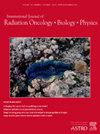Evaluating Toxicity and Interaction Outcomes of Systemic Therapy and Stereotactic Ablative Radiotherapy for Oligometastatic Disease: A Secondary Analysis of the Phase II SABR-5 Trial
IF 6.4
1区 医学
Q1 ONCOLOGY
International Journal of Radiation Oncology Biology Physics
Pub Date : 2024-10-01
DOI:10.1016/j.ijrobp.2024.07.031
引用次数: 0
Abstract
Purpose/Objective(s)
While SABR is known for its overall low toxicity and safety, there remains a research gap regarding its combined use with specific systemic therapies. This study aims to evaluate the toxicity of SABR in combination with various systemic therapies. The hypothesis is that certain systemic therapies would significantly increase the risk of Grade 2+ and Grade 3+ radiation therapy-related toxicities when used concurrently with Stereotactic Ablative Radiotherapy (SABR).
Materials/Methods
A secondary analysis of the SABR-5 trial compared grade 2+ and 3+ toxicities associated with SABR until the last follow-up in patients receiving high-risk or non-high-risk systemic therapy at intervals of 3 months, 2 weeks, 1 week, and concurrently with SABR. High-risk systemic therapy was a priori defined, based on previous literature, as drugs that, when given close to SABR, may increase treatment toxicity. This category encompasses cytotoxic chemotherapy drugs, multi-targeted tyrosine kinase inhibitors, cyclin-dependent kinase 4/6 inhibitors, epidermal growth factor receptor inhibitors, anti-vascular endothelial growth factor agents, and anti-cytotoxic T-lymphocyte-associated protein 4 agents.
Results
Among the 381 patients, the actuarial rates of grade 2+ and 3+ toxic effects were as follows: for patients not on systemic therapy 3 months prior to SABR (n = 202), the rates were 17.3% and 3.5%, respectively; for patients on non-high-risk systemic therapy concurrent with SABR (n = 102), the rates were 18.6% and 3.9%, respectively; and for patients on high-risk systemic therapy concurrent with SABR (n = 5), the rates were notably higher at 60% and 40%, respectively. On multivariable analysis, concurrent use of high-risk systemic therapy was associated with a higher risk of grade 2+ (OR = 7.15, P = 0.043) or 3+ toxic effects (OR = 13.9, P = 0.015). Significance was not observed when high-risk drugs were used only within 1 week, 2 weeks, or 3 months of SABR, nor with the use of any non-high-risk drugs. A second adverse factor included increased tumor diameter (per 1 cm increment; G2+ OR = 1.25, P < 0.001; G3+ OR = 1.27, P = 0.015).
Conclusion
High-risk drugs have demonstrated a potential of increased SABR-related toxicity, warranting caution in their concurrent use with SABR. In contrast, the combination of non-high-risk drugs with SABR may be safe. Ongoing efforts are essential to identify potential risks and uncertainties associated with this therapeutic combination.
评估治疗寡转移性疾病的全身疗法和立体定向消融放疗的毒性和相互作用结果:SABR-5 二期试验的二次分析
目的/目标:SABR 因其总体毒性低、安全性高而闻名,但在与特定系统疗法联合使用方面仍存在研究空白。本研究旨在评估 SABR 与各种系统疗法联合使用的毒性。材料/方法SABR-5试验的二次分析比较了在3个月、2周、1周和与SABR同时接受高风险或非高风险系统治疗的患者中,直到最后一次随访前与SABR相关的2+级和3+级毒性。根据以前的文献,高风险系统治疗被预先定义为在接近 SABR 时使用可能会增加治疗毒性的药物。此类药物包括细胞毒性化疗药物、多靶点酪氨酸激酶抑制剂、细胞周期蛋白依赖性激酶4/6抑制剂、表皮生长因子受体抑制剂、抗血管内皮生长因子药物和抗细胞毒性T淋巴细胞相关蛋白4药物。结果381名患者中,2+级和3+级毒性反应的精算率如下:SABR前3个月未接受系统治疗的患者(n = 202),2+级和3+级毒性反应的发生率分别为17.3%和3.5%;SABR 同时接受非高风险系统治疗的患者(102 人),2+ 和 3+ 的比例分别为 18.6% 和 3.9%;SABR 同时接受高风险系统治疗的患者(5 人),2+ 和 3+ 的比例明显更高,分别为 60% 和 40%。在多变量分析中,同时使用高风险系统疗法与较高的 2+ 级(OR = 7.15,P = 0.043)或 3+ 级毒性反应风险(OR = 13.9,P = 0.015)相关。如果仅在SABR后1周、2周或3个月内使用高风险药物,或使用任何非高风险药物,则未观察到显著性。第二个不利因素包括肿瘤直径增大(每增大 1 厘米;G2+ OR = 1.25,P < 0.001;G3+ OR = 1.27,P = 0.015)。相比之下,非高风险药物与 SABR 的联合使用可能是安全的。必须继续努力,以确定与这种治疗组合相关的潜在风险和不确定性。
本文章由计算机程序翻译,如有差异,请以英文原文为准。
求助全文
约1分钟内获得全文
求助全文
来源期刊
CiteScore
11.00
自引率
7.10%
发文量
2538
审稿时长
6.6 weeks
期刊介绍:
International Journal of Radiation Oncology • Biology • Physics (IJROBP), known in the field as the Red Journal, publishes original laboratory and clinical investigations related to radiation oncology, radiation biology, medical physics, and both education and health policy as it relates to the field.
This journal has a particular interest in original contributions of the following types: prospective clinical trials, outcomes research, and large database interrogation. In addition, it seeks reports of high-impact innovations in single or combined modality treatment, tumor sensitization, normal tissue protection (including both precision avoidance and pharmacologic means), brachytherapy, particle irradiation, and cancer imaging. Technical advances related to dosimetry and conformal radiation treatment planning are of interest, as are basic science studies investigating tumor physiology and the molecular biology underlying cancer and normal tissue radiation response.

 求助内容:
求助内容: 应助结果提醒方式:
应助结果提醒方式:


